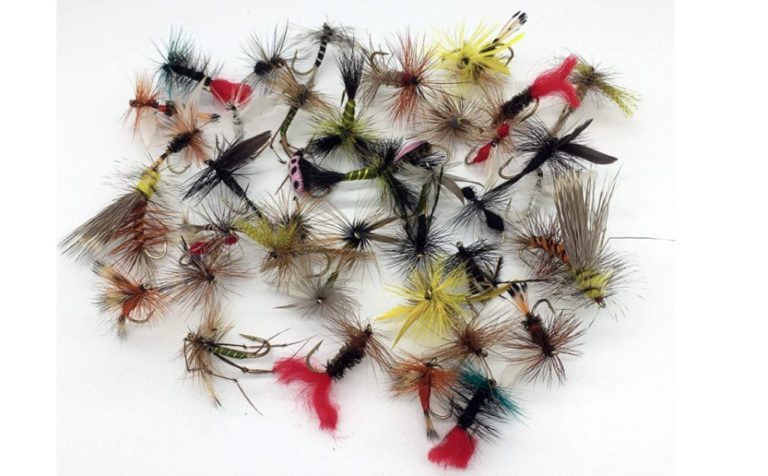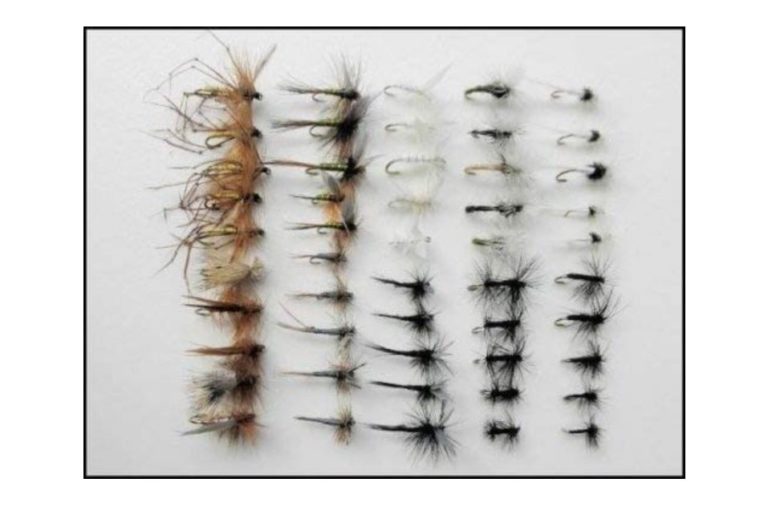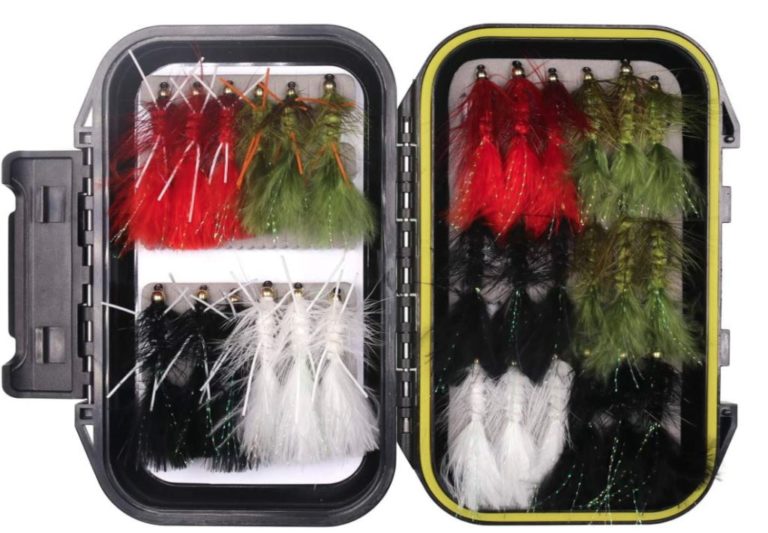Wet Fly vs Dry Fly: Top Choices for Everyday Use
Skip To Save Time
Wet Fly vs Dry Fly: Top Choices for Everyday Use
Wire. Feathers. Twine. Individually, each of these three items have purpose but not for the angler. Spend some time combining the three, and you have one of the finest trout lures known. The simple fly mimics the natural emerging hatch of insects trout gorge themselves on in the late spring and summer. Anglers who tempt their quarry with the fly are often some of the most skilled and proficient of all anglers. The skill, accuracy and precision necessary when fly fishing is not for the novice or impatient. Those who would master the art of the fly presentation are often rewarded handsomely with both prize and bragging rights.
Fly fishing itself comes down to one of two choices: the dry fly and the wet fly. Of these, the dry fly can be further broken down into hatches and terrestrials. The wet fly can be broken down into streamers, emergents and nymphs. Both lures have their place and use on the stream and river, and Catch and Release Fishing has used both with exceptional success.
This article is going to introduce you to a few examples of pre-tied flies, specifically the Dry fly Vs Wet fly. It is a hope one day you would tie your own, but until then, please consider the patterns we have selected. These closely mimic the same sorts of common insects the trout normally feed on as well as well made. Fly tying is expensive with start up costs, so we recommend using pre-tied flies as you begin or continue your fly angling experience.
One thing to note – when Catch and Release fishing talks about flies, this refers to any number of different lures tied onto the end of a fly line. A high floating mouse pattern tied onto a fly line is as much a fly as a small sinking nymph.
The wise fly fishing angler knows to keep a variety of flies on them at all times. This means a selection of nymphs, wets, streamers and dry flies. One of the exciting elements of trout fishing with a fly rod is trying to match what the trout are eating that day. Trout are finicky eaters. What they gorge themselves on one day may have them turning away the next.
Lastly before we take you to the flies themselves, remember to practice good conservation techniques. Use a barbless hooks for fishing , handle fish as little as possible with wet hands and return the fish quickly to the water. Keep only what you need and plan to enjoy. Release the extra back into the stream for another day.
The dry fly
The dry fly is the epitome of the fly fishing for trout experience. Hearing the ‘plop’ and seeing the bubble left behind from the rising trout is certainly a sublime experience. However, dry flies have their place. Situations for most dry fly angling is very precise and often with a tight window of time as emergents do not live long. Their sole goal is mating before dying, and many do not last beyond 24 hours time.
Dry flies are not suitable when the water is muddied or stained as trout do not like silt in their gills. Smaller flies, like a size 14 and below, are not well suited for fast waters. Basically, the standard dry fly is limited to runs, slow moving deeper water; riffles – faster, shallow water that creates whitewater; whitewater – fast moving, violent water that flows over rocks creating white bubbles.
This is not to say dry flies do not work in faster moving waters. Riffles and whitewaters are actually more oxygen rich environments, and trout do lie in these areas behind rocks waiting for passing prey.the
The dry fly also must be presented exceptionally accurately for the trout to bite. This means keeping the fly as stationary as possible while floating downstream, accomplished by ‘mending’ the fly line’s bow in the swifter water while the fly rests in slower moving water.
Again, dry flies are not for the novice and require time and still to master. Mastery, on the other hand, results in some excellent experiences on the water.
Check out our fly fishing hook size chart
Catch and Release’s Dry Fly Recommendations
1. BestCity Fly Fishing Dries Selection
This selection is an Amazon.com top choice, and one that Catch and Release Fishing has used in the past for the stream and learning to tie flies. Expertly tied patterns feature quality hackle (for the body and flotation) and wings (necessary for balance). Specifications:
40 flies of various types both emergent and terrestrials
Sizes 8 to 16
Exceptionally sharp, single hooksm
2. Summer Trout Fishing Flies
The summer is when most hatches occur and is also when the fly angler will be on the water after the trout. This selection of flies mimics the majority of hatches anglers are likely to see streamside. Specifications:
50 total flies
Variety of sizes
Some named flies after specific species
3. YZD Realistic Fly Fishing Flies Set
Insects rising out of the stream itself are not the only dry flies that a trout will take. Terrestrials – bees, wasps, ants and the like – are all common fare for the trout. Terrestrials are also a fantastic search pattern – flies anglers use to determine what trout are most likely feeding on that day. Specifications:
Incredibly lifelike patterns
Set of 12 to 24
Foam bodies ride high in the water
4. Flies Direct Mouse Rat Assortment
This may seem strange verging on plain weird, but trout will strike at and eat mice if one happens to fall into the stream or river. Many people do not realize that trout are voracious predators. Mice in the stream are a quick, easy and filling meal. Specifications:
Sold in packages of four
Tied with spun deer hair for flotation
Works exceptionally well in fast riffles and white water
Wet Flies
The wet fly produces with much more regularity than a dry, mostly because wet flies are fished year around. Winter months in particular, when trout huddle into deep pools, areas of still, slow moving, deep water and feed on nymphs almost exclusively, wet flies are the fly of choice.
Wet flies also include the streamer, a fly pattern tied to resemble a bait fish. Fished in a method similar to that of a wet fly, the streamer produces year round.
Wet flies are usually less expensive to purchase and tie because the hackles used are not the Grade A hackle, necessary for the flotation aspect of the dry fly.
It is common to use strike indicators for wet flies as well. Trout do not rise and leave behind a tell-tale bubble for wet flies as they do dries. A strike indicator lets the angler know when the trout has picked up the fly or nymph. Catch and Release Fishing prefer the Alomejor EVA Fly Fishing Floats Strike Indicator. These glue onto the tippet with simple pressure and are small enough not to spook wary trout. A complete angler keeps several of these indicators on hand at all times.
Catch and Release Fishing’s Wet Fly Recommendations
1. BestCity 50 plus Fishing Flies WET Selection
This is the go-to selection when on the stream and using search patterns for trout. The variety of sizes and colors are what is often necessary when learning trout feeding patterns. Specifications:
50 total flies
Sizes 10 to 16
Tackle box
2. BestCity Fishing Flies Nymph Bead Head
Winter trout are often deep, and the angler has a limited window of time to get the fly in front of the trout in this case. The extra weight of the beads for the eyes and head of these nymph patterns achieve that task while maintaining realism. Specifications:
32 different nymphs of various insect species
Brightly colored with gold plated eyes
Tackle box
3. Wifreo 30PCS Wooly Bugger Fly Trout Fishing Streamer Assortment
Do not let the silly sounding name of ‘wooly bugger’ fool you. This particular streamer is one of the best on the market when streamers are all that is on the trout menu. In fact, do not be surprised if something besides a trout takes an interest in the wooly bugger. Pike, bass and other species will eat streamers as well. Specifications:
30 total flies in size and color
Sizes 4, 6, 8
Waterproof tackle box
4. Shrimp Fishing Flies
There are some species of shrimp that live in freshwater. These shrimp make fantastic trout fodder as well. Specifications:
Sizes 6, 8, 10
Close imitation to actual shrimp
Package of 12
How to tell a dry fly from a wet fly
Experienced fly anglers can tell the difference between the two types of flies with an easy glance. Less experienced anglers not so. Here are the best tips to consider when deciding if the fly is a dry or wet if you are not absolutely certain.
Stand – Does the fly stand almost completely vertically and rather tall? If so, it is a dry. The dry fly’s hackles make the fly stand high so it will float on the water. Wet flies are shorter with shorter hackles.
Shape – All dry flies are tied on a straight hook. Wet flies may use a bent hook, usually for a nymph.
Materials – Dry flies can be tied with spun hair or foam like materials. Wet flies often have gold, silver or other shiny material wrapped down the body.
Hackle – Hackles refer to the feathers tied around the fly for flotation and/or dress. Dry fly hackles sit very vertically on the front of the fly almost exclusively and are of a higher quality. Wet fly hackles bend back toward the shank of the hook, are often thick and spaced down the entire fly.
Weight – Wet flies often have lead wrapped around the hook shank or eyes tied to the front of the fly. This helps the fly sink down to the trout low in the water.
Streamers – There are some dry flies that float, mouse patterns for example, but a streamer is usually just that – streamlined to swim through the water like a bait fish.
Terrestrial – Terrestrial insects like ants, beetles, crickets and the like are normally dry flies. There are some instances when they can be wet, but this is not as frequent as being used as a dry fly.
Mice – Mice do not live in the water but on occasion slip and fall into rivers and streams. They are expert swimmers, however.
When to use a wet fly vs. a dry fly
This is actually a very easy question to answer – when there is not a hatch coming up from the water is the best time to use a wet over a dry. Other times wet flies are more appropriate include when the water is stained (actually best not to trout fish at all in stained or muddy water), in the fall and winter months, when searching for a fly trout will take and when there is no apparent visible trout action on the water’s surface.
Trout that are in deep water, pools, will not rise the distance to take dry flies. Wet flies, fast sinking at that, are necessary to get the fly down to the trout’s level. A trout is like any predator and will not expend more energy than necessary for a meal.
Dry flies are appropriate when there is a visible hatch, insects flying around the stream mating, and you see trout rising to the surface with the small bubble evident after swallowing the insect. Dry flies, as a rule, work better in runs, small riffles and some whitewater situations.
Are nymphs wet or dry flies?
The nymph is a larva, early stage of a fly. Nymphs live on the bottom of streams and rivers where they feed on various things from detritus to small fish. When ready to emerge, the nymphs float up to the surface where the fly emerges.
Is a nymph a wet or dry fly? It is safer to assume nymphs are wets because this is where the spend the majority of their lifespan.
What does a dry fly look like?
This is not an easy question to answer. A dry fly can look like a number of different insects or small mammals like rodents. Dry flies can mimic flies that rise from a nymph stage into adult hood, ants, beetles, crickets, dragonflies, damselflies or mice. There is not one easy answer to what a dry fly looks like when mentioning hatches, insects emerging from nymphs into the air. Instead, it is best to have a guide to consult for the best match depending on the month.
Certain terrestrial fly patterns are also excellent for search patterns since terrestrials are common in and around streams around the year with the possible exception of the deep winter.
What are dry flies used for?
Starting in April, insects rise from under the water, change into their adult forms, mate and die. This is called a ‘hatch.’ The majority of dry flies fished on streams and rivers match these insects. The insects do ride on the surface of the water before and after mating, and this is when trout will feed on them.
Anytime the water is clear, skies are clear and it is just a lovely day in general is a good time to fish a dry fly – be it from a hatch, insect or mouse pattern.
Do wet flies sink?
By the very nature of the name, wet fly, wet flies do sink. The goal of a wet fly is to be below the surface of the water mimicking a nymph, emergent, worm, shrimp or similar trout food. Wet flies are also excellent choices for searcher patterns – flies anglers use to determine what the trout are biting.
One of the great advantages of fly fishing and flies in general is that they are normally a single hook. This means the angler can either render a barbed hook barbless or tie flies onto barbless hooks. It is the goal of Catch and Release Fishing to teach good conservation techniques and provide for the next generation of anglers to have an opportunity at a trout on wire, feathers and twine.
We hope to see you on the stream and perhaps share flies, tips and secret patterns for success!











